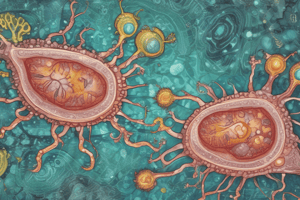Podcast
Questions and Answers
What is the characteristic feature of the chromatoidal bar in Entamoeba histolytica cyst?
What is the characteristic feature of the chromatoidal bar in Entamoeba histolytica cyst?
- It has a rough end
- It has a smooth end (correct)
- It is a characteristic of mature cysts only
- It is absent in immature cysts
Which of the following intestinal helminths is NOT measured in micrometers (µm)?
Which of the following intestinal helminths is NOT measured in micrometers (µm)?
- Clonorchis (correct)
- Trichuris trichiura
- Hymenolepis nana
- Ascaris
What is the purpose of faecal microscopic examination in the diagnosis of intestinal parasites?
What is the purpose of faecal microscopic examination in the diagnosis of intestinal parasites?
- To identify the type of parasitic infection (correct)
- To assess the nutritional status of the individual
- To examine the gut motility
- To detect the presence of bacteria
Which of the following parasites is a protozoan?
Which of the following parasites is a protozoan?
What is the characteristic feature of Entamoeba histolytica cyst in terms of the number of nuclei?
What is the characteristic feature of Entamoeba histolytica cyst in terms of the number of nuclei?
Which of the following intestinal helminths is classified as a cestode?
Which of the following intestinal helminths is classified as a cestode?
What is the size of the Enterobius sinensis?
What is the size of the Enterobius sinensis?
Which of the following parasites has a size of 70 µm x 40 µm?
Which of the following parasites has a size of 70 µm x 40 µm?
What is the primary method for diagnosing parasitic infections in humans?
What is the primary method for diagnosing parasitic infections in humans?
What is the size of the Schistosoma japonicum?
What is the size of the Schistosoma japonicum?
Which of the following parasites is characterized by the presence of a red cell in its cytoplasm?
Which of the following parasites is characterized by the presence of a red cell in its cytoplasm?
Which of the following parasites has a variable size?
Which of the following parasites has a variable size?
What is the primary reason for understanding parasite life cycles and routes of transmission?
What is the primary reason for understanding parasite life cycles and routes of transmission?
What is the size of the Paragonimus westermani?
What is the size of the Paragonimus westermani?
What is the term for the study of the distribution and determinants of parasitic infections?
What is the term for the study of the distribution and determinants of parasitic infections?
Which of the following parasites has a size of 140 µm x 75 µm?
Which of the following parasites has a size of 140 µm x 75 µm?
Which of the following statements is true about parasitic infections?
Which of the following statements is true about parasitic infections?
What is the size of the Ascaris lumbricoides?
What is the size of the Ascaris lumbricoides?
What is the term for the study of the morphology of protozoa and helminths?
What is the term for the study of the morphology of protozoa and helminths?
Which of the following parasites has a size of 160 µm x 60 µm?
Which of the following parasites has a size of 160 µm x 60 µm?
Study Notes
Parasitic Infections
- There are no vaccines registered for use against any human parasite.
- Understanding parasite life cycles and routes of transmission (epidemiology) is key to accurate diagnosis, prevention, and control of parasitic infections.
Faecal Microscopic Diagnosis of Intestinal Helminths
- Hymenolepis nana: 40 µm x 30 µm
- Trichuris trichiura: 45 µm x 30 µm
- Ascaris lumbricoides: 50 µm x 20 µm
- Diphyllobothrium latum: 70 µm x 40 µm
- Clonorchis sinensis: 30 µm x 16 µm
- Enterobius: 55 µm x 25 µm (fertilized) and 60 µm x 35 µm (unfertilized)
- Hookworm: 70 µm x 30 µm
- Taenia spp.: size variable
Faecal Microscopic Diagnosis of Intestinal Protozoa
- Entamoeba histolytica trophozoite: 5 µm (acid-fast stain), has a red cell in cytoplasm
- Entamoeba histolytica cyst: 15 µm, has two nuclei, smooth-ended chromatoidal bar
Parasite Identification
- Schistosoma japonicum: 85 µm x 60 µm
- Paragonimus westermani: 110 µm x 60 µm
- Fasciolopsis buski: 135 µm x 80 µm
- Fasciola hepatica: 140 µm x 75 µm
- Schistosoma mansoni: 160 µm x 60 µm
- Schistosoma haematobium: 170 µm x 60 µm
Diagnosis
- Diagnosis is achieved through microscopic analyses of faecal, blood, tissue or sputum samples or PCR or antibody tests.
Studying That Suits You
Use AI to generate personalized quizzes and flashcards to suit your learning preferences.
Description
Identify the characteristics of Entamoeba histolytica cyst under a microscope. Observe the nuclei and chromatoidal bar. This quiz is essential for faecal microscopic diagnosis of intestinal helminths.




